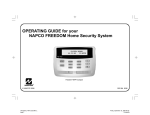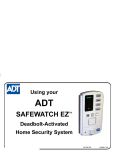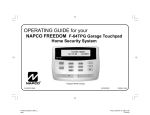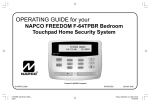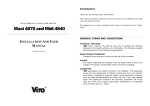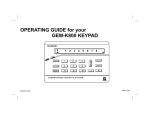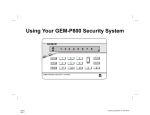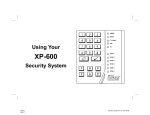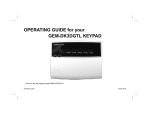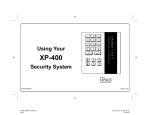Download NAPCO FREEDOM
Transcript
R Using your NAPCO FREEDOM Deadbolt-Activated Home Security System Freedom Touchpad © NAPCO 2005 aFreedom_F-TP_OI305.25_U... page 1 PATENTED OI305 10/05 1 Friday, October 28, 2005 15:56 Composite INTRODUCTION Congratulations on your purchase of a new Deadbolt-Activated NAPCO FREEDOM Security System. This revolutionary new concept in residential security makes using your system easier than ever before possible, because the system uses its computerized control panel to continually monitor the status of your entry door (and deadbolt). It actually anticipates what command it should expect from you next-simply requiring just one button to press to effortlessly operate your security system, whether you’re going, returning or staying in for the night. Now everyone in your family, young and old alike, will enjoy the true peace-of-mind you would expect from a quality, state-ofthe-art NAPCO Security System, without the fuss of remembering confusing numerical codes to operate it. Simplicity and convenience begin with your System’s one-touch STAY or AWAY buttons, then just lock or unlock the door as usual! Day in and day out, that’s all there is to it. This booklet contains important information about the operation of your NAPCO FREEDOM Security System. Please read it through and retain it for handy reference. Because your system is customized for your home and lifestyle, you may find subjects mentioned here, that don’t apply to your system. Rest assured your security system has been configured by your Security Professional to best suit you, and the system itself has been meticulously designed and engineered to the highest industry standards. Please test your system at least once a week as described below. IMPORTANT - TEST YOUR SYSTEM WEEKLY From a Ready Condition (Disarmed State) 1 Test your siren and central station communicator: BYPASS Hold Down the BYPASS button for 4 seconds (until the Touchpad beeps). The system will generate a test report to central station and two momentary chirps of the siren. • If the siren does not sound or sounds week, call for service. • If the system indicates a low battery system trouble (trouble light TBL flashing 2 times), call for service. • If the system indicates a communication failure system trouble (TBL flashing 3 times), call for service. (The communication failure system trouble may take a few minutes to appear.) 2 A subsequent press of the SILENCE button will silence the trouble indication. aFreedom_F-TP_OI305.25_U... page 2 2 Test your motion sensors and other protective devices: Hold Down the BYPASS button for 8 seconds (until the second hold-down beep). • Walk through the areas protected by motion sensors. The F-TP Touchpad will beep when the zone is violated and again when the zone is restored. • Open and close all protected doors and windows and listen for the corresponding Touchpad beeps. After testing the protective devices, the F-TP Touchpad ARMED indicator will flash out the zone number of all zones which have been activated. Press the SILENCE button to clear the display and end the test. If any devices fail to respond when activated or register on the F-TP Touchpad display as described above, call for service. Friday, October 28, 2005 15:56 Composite T AB L E O F C O N T E N T S TABLE OF CONTENTS INTRODUCTION.............................................................................. 2 TESTING THE SYSTEM.................................................................. 2 F-TP TOUCHPAD INDICATORS ..................................................... 4 F-TP TOUCHPAD CONTROLS ...................................................... 5 ARMING WHEN LEAVING............................................................... 6 BYPASSING FAULTED ZONES ..................................................... 7 ARMING WHEN STAYING HOME................................................... 8 ARMING AND LEAVING WITH OTHERS STAYING ....................... 9 EXITING WITH THE SYSTEM ALREADY ARMED ........................ 10 EMERGENCY BUTTONS ................................................................ 12 DISARMING THE SYSTEM ............................................................. 13 SILENCING AN ALARM................................................................... 14 FIRE PROTECTION......................................................................... 15 SYSTEM TROUBLE ERROR CODES ............................................. 17 ZONE LIST....................................................................................... 19 ENROLLING A NEW F-IFOB ........................................................... 20 LOST KEY MODE ............................................................................ 21 FCC PART 68 STATEMENT ........................................................... 22 LIMITATIONS OF THIS ALARM SYSTEM....................................... 23 LIMITED WARRANTY...................................................................... 25 FCC PART 15 STATEMENT............................................................ 27 aFreedom_F-TP_OI305.25_U... page 3 R IF THE ALARM IS SOUNDING: To silence an alarm, insert your F-IFOB key into the slot on the Touchpad and remove when alarm has silenced. Proceed with caution! (See pages 14 & 15). ALARM TIME OUT: _________ Minutes FOR SERVICE, CALL: _____________________ TO CANCEL AN ALARM REPORT, CALL: ____________________ 3 Friday, October 28, 2005 15:56 Composite F - T P T O U C H P A D I N D I C AT O R S The green READY light shows the status of the zones in your system: ON indicates that all zones are secure and the system is ready to be armed. FLASHING indicates that at least one zone is open. To determine the open zone, count the number of flashes and refer to the zone list on your security panel. OFF indicates that one or more of the optional monitored deadbolts in the system is not locked. All other monitored deadbolts must be locked before arming. The red ARMED light ON indicates that the system is armed. BLINKING with the siren sounding indicates that the system is in alarm. BLINKING with no siren indicates Alarm Memory (the alarm has been silenced or timed out). To determine the zone in alarm, count the number of flashes and refer to the zone list on your security panel. Press SILENCE to clear the alarm memory. (see page 13) The yellow STAY light ON indicates that the system is armed in the STAY mode, allowing free movement throughout the premises, while maintaining perimeter protection. The red FIRE light will flash to indicate that the system is in a Fire Alarm Condition*. If a fire is in progress, evacuate the premises immediately! * Note: This feature may not apply to your system. Consult your installer to determine if your system includes fire protection. READY ARMED STAY FIRE TBL • The yellow trouble TBL light will light and the F-TP Touchpad sounder will pulse to indicate that a system trouble is present. If zone(s) have been bypassed, TBL will light steadily. (See SYSTEM TROUBLE ERROR CODES, Page 17). The green AC Light ON indicates that AC Power is present. 4 aFreedom_F-TP_OI305.25_U... page 4 Friday, October 28, 2005 15:56 Composite F-TP TOUCHPAD CONTROLS STAY Button - Press to arm system in the STAY mode. Perimeter devices such as windows and doors will be protected, while interior protective devices such as motion sensors will be de-activated, allowing free movement throughout the premises. AWAY Button - Press to arm system in AWAY mode when no one is to remain home. System will be fully armed with all perimeter and interior devices activated. BYPASS Button - This button has multiple functions, depending on the state of the panel. BYPASS - If you are attempting to arm the system with open zones that cannot be immediately repaired, press BYPASS to temporarily remove these zones from the system. The F-TP Touchpad will beep and trouble TBL will light steady. Press STAY or AWAY to arm the system as usual (see page 7). TEST - To test the system, hold down the BYPASS button for 4 seconds to generate a test report to central station and chirp the siren. If the test fails, the F-TP Touchpad will beep and the trouble light (TBL) will flash. Hold down BYPASS for 8 seconds to do a “system walk test” of your protective devices. Press SILENCE to reset. (See page 2). SILENCE Button - Press to silence a Fire Alarm* (page 15), silence system troubles and view system troubles (page 17). * Note: This feature may not apply to your system. Consult your installer to determine if your system includes fire protection. Hold down for 4 seconds to remove F-IFOBs from the System - See page 20. EMERGENCY BUTTONS POLICE EMERGENCY Press to alert Central Station of a Police Emergency. FIRE EMERGENCY Press to alert Central Station of a Fire Emergency. AUXILIARY EMERGENCY Press to alert Central Station of an Auxiliary Emergency. SIREN - Will sound a LOUD steady sweep tone when intrusion is detected or a distinct pulsating tone for a fire alarm condition. MOTION SENSOR - Detects movement in the premises. Do NOT block. F-IFOB - The F-IFOB is a uniquely coded digital key which must be used to disarm the system and silence the siren in case of alarm. To silence an alarm, simply insert into the F-IFOB slot on the F-TP Touchpad and remove when alarm has silenced. 5 aFreedom_F-TP_OI305.25_U... page 5 Friday, October 28, 2005 15:56 Composite A R M I N G W H E N L E AV I N G If you are leaving with no other family members remaining home: 1 READY Check the F-TP Touchpad indicators. The green READY light should be ON-STEADY, indicating that the system is ready to arm. • • 2 AWAY ARMED 3 4 6 aFreedom_F-TP_OI305.25_U... page 6 If the green READY light is BLINKING, this indicates that a zone is faulted. The READY light is blinking out the zone number of the open zone. Count the flashes and look at your zone list to see which zone is open and secure it (close the door or window, etc.). If you cannot immediately secure the zone, it may be bypassed (see page 7). If the green READY light is OFF, another monitored deadbolt is not locked. All other monitored deadbolts must be locked before the system can be armed. Go to the other deadbolt location and lock it. Press the AWAY button. If you change your mind after pressing AWAY, press SILENCE to clear arming. The ARMED indicator will begin to flash, indicating the 60 second exit delay period. Open the door and exit. Lock the deadbolt from the outside to arm the system. The F-TP Touchpad will give one chirp to indicate the system has armed. If the deadbolt has not been locked within 60 seconds of pressing AWAY, the system will revert back to a disarmed state. If the system detects movement inside the premises within 60 seconds of arming, it will automatically revert to Stay mode, providing perimeter protection with the interior protection (motion sensors) turned off. (See ARMING WHEN STAYING HOME - page 8). Friday, October 28, 2005 15:56 Composite B Y P AS S I N G F A U L T E D Z O N E S If you are trying to arm with a faulted zone or zones, the green READY light will be blinking out the number of the faulted zones. If you cannot repair the zone(s), they may be temporarily removed from the system, or bypassed, using the following procedure: 1 BYPASS TBL 2 STAY Press the BYPASS button. The F-TP Touchpad will beep and the yellow Trouble indicator will light ON STEADY. Press either the STAY or AWAY button. AWAY 3 4 If arming AWAY, open the door and exit. Lock the deadbolt to arm the system with the faulted zones bypassed. Warning: Bypassed zones are unprotected. If a faulted zone cannot be secured, have the system checked as soon as possible. 7 aFreedom_F-TP_OI305.25_U... page 7 Friday, October 28, 2005 15:56 Composite A R M I N G W H E N S T AY I N G H O M E Arming in the Stay mode allows you to remain home with the perimeter protection active and the interior protection off, so that you may move freely about the premises. 1 READY Check the F-TP Touchpad indicators. The green READY light should be ON-STEADY, indicating that the system is ready to arm. • • 2 STAY ARMED STAY If the green READY light is BLINKING, this indicates that a zone is faulted. The READY light is blinking out the zone number of the open zone. Count the flashes and look at your zone list to see which zone is open and secure it (close the door or window, etc.). If you cannot immediately secure the zone, it may be bypassed (see page 7). If the green READY light is OFF, another monitored deadbolt is not locked. All other monitored deadbolts must be locked before the system can be armed. Go to the other deadbolt location and lock it. Press the STAY button. If the deadbolt is already locked, the ARMED indicator will light and STAY will begin to flash, indicating the 60 second exit delay period. The system will arm in the Stay mode in 60 seconds. If the deadbolt is NOT locked, lock the deadbolt from the inside to arm the system. If the deadbolt has not been locked within 60 seconds of pressing STAY, the system will revert back to a disarmed state. 3 STAY The STAY indicator will stop flashing and light steady, indicating the system is armed in the Stay mode. 8 aFreedom_F-TP_OI305.25_U... page 8 Friday, October 28, 2005 15:56 Composite A R M I N G AN D L E AV I N G W I T H O T H E R S S T A Y I N G If you are arming and leaving with other family members remaining home: 1 READY Check the F-TP Touchpad indicators. The green READY light should be ON-STEADY, indicating that the system is ready to arm. • If the green READY light is BLINKING, this indicates that a zone is faulted. The READY light is blinking out the zone number of the open zone. Count the flashes and look at your zone list to see which zone is open and secure it (close the door or window, etc.). If you cannot immediately secure the zone, it may be bypassed (see page 7). • 2 If the green READY light is OFF, another monitored deadbolt is not locked. All other monitored deadbolts must be locked before the system can be armed. Go to the other deadbolt location and lock it. Press the STAY button. STAY STAY 3 4 STAY will begin to flash, indicating the 60 second exit delay period. Open the door and exit. Lock the deadbolt from the outside to arm the system. If the deadbolt has not been locked within 60 seconds of pressing STAY, the system will revert back to a disarmed state. 9 aFreedom_F-TP_OI305.25_U... page 9 Friday, October 28, 2005 15:56 Composite E X I T I N G W I T H T H E S Y S T E M AL R E A D Y A R M E D If the system is Armed STAY and you are leaving with other family members remaining home: 1 STAY ARMED STAY Press the STAY button. The ARMED indicator will light and STAY will begin to flash, indicating the 60 second exit delay period. 2 Unlock the deadbolt from the inside. System will disarm. 3 4 Open the door and exit. Lock the deadbolt from the outside to arm the system. If the deadbolt has not been locked within 60 seconds of pressing STAY, the system will revert back to a disarmed state. 10 aFreedom_F-TP_OI305.25_U... page 10 Friday, October 28, 2005 15:56 Composite E X I T I N G W I T H T H E S Y S T E M AL R E A D Y A R M E D If the system is Armed STAY and you are leaving with NO other family members remaining home: 1 AWAY ARMED Press the AWAY button. The ARMED indicator will begin to flash, indicating the 60 second exit delay period. 2 Unlock the deadbolt from the inside. System will disarm. 3 4 Open the door and exit. Lock the deadbolt from the outside to arm the system. The F-TP Touchpad will give one chirp to indicate the system has armed. If the deadbolt has not been locked within 60 seconds of pressing AWAY, the system will revert back to a disarmed state. If the system detects movement inside the premises within 60 seconds of arming, it will automatically revert to Armed STAY mode, providing perimeter protection with the interior protection (motion sensors) turned off. (See ARMING WHEN STAYING HOME - page 8). 11 aFreedom_F-TP_OI305.25_U... page 11 Friday, October 28, 2005 15:56 Composite EMERGENCY BUTTONS Emergency Buttons (Only available if programmed). The Emergency Buttons, if programmed, are always active, whether the system is armed or disarmed. The Emergency Button must be Held Down for 3 seconds to activate the emergency alarm and transmit the signals to central station. Police Emergency Hold down the Police Emergency button to alert the central station of a police emergency. * (Police Emergency programmed? YES NO) Fire Emergency Hold down the Fire button to alert the central station of a fire emergency. * (Fire Emergency programmed? YES NO) Auxiliary Emergency Hold down this button to alert the central station of an auxiliary emergency. * (Auxiliary Emergency programmed? YES NO) Auxiliary Emergency: _______________________________________ 12 aFreedom_F-TP_OI305.25_U... page 12 Friday, October 28, 2005 15:56 Composite D I S AR M I N G T H E S Y S T E M Disarming when returning home: When returning home, simply unlocking your deadbolt from the outside will automatically disarm the system. The red ARMED light will go out and the green READY light will come on. If an alarm has occurred while you were away, the red ARMED light will be flashing and the F-TP Touchpad sounder will be active. Proceed with caution! If you suspect that an intruder may still be in the premises, leave immediately and call authorities from a neighbor's telephone. Disarming when home (Armed Stay): When home with the system armed in the Stay mode, unlocking the deadbolt from the inside will disarm the system. The red ARMED light and yellow STAY will go out and the green READY light will come on. The system may also be disarmed with the F-IFOB. To disarm the system, insert your F-IFOB key into the IFOB slot on the F-TP Touchpad and remove when the system is disarmed. Ambush Feature (Optional): If an intruder forces you to disarm your system upon entry, you can silently signal an emergency while appearing to be merely disarming the keypad. Send a silent "ambush" alarm to the central station by pressing the SILENCE button for 2 seconds (within 15 seconds of disarming the system). There will be no indication that a silent alarm has been sent. Note: Consult your installer to determine if the Ambush feature is enabled in your system. 13 aFreedom_F-TP_OI305.25_U... page 13 Friday, October 28, 2005 15:56 Composite S I L E N C I N G A N AL AR M If an alarm occurs while you are at home: ARMED The F-TP Touchpad siren will sound and the red ARMED light will flash. Proceed with caution! If you suspect that an intruder may still be in the premises, leave immediately and call authorities from a neighbor's telephone. To silence the alarm, insert your F-IFOB key into the IFOB slot on the F-TP Touchpad and remove when alarm has silenced. ARMED The red ARMED light will continue to flash the number of the zone(s) on which the alarm occurred. Determine which zone caused the alarm and then press SILENCE to clear the alarm memory. If an alarm occurs while you are away: ARMED When you unlock the deadbolt to enter, the F-TP Touchpad sounder will activate and the red ARMED light will be flashing to warn you that an alarm had occurred while you were away. Proceed with caution! If you suspect that an intruder may still be on the premises, leave immediately and call authorities from a neighbor's phone. To disarm the system, you must insert your F-IFOB key into the F-IFOB slot on the F-TP Touchpad. If the system is not disarmed in 30 seconds, the alarm will sound. ARMED The red ARMED light will continue to flash the number of the zone(s) on which the alarm occurred. Determine which zone caused the alarm and then press SILENCE to clear the alarm memory. 14 aFreedom_F-TP_OI305.25_U... page 14 Friday, October 28, 2005 15:56 Composite FIRE PROTECTION* If a fire is detected, the siren will sound a distinct pulsating tone and the FIRE indicator on the F-TP Touchpad will be flashing. If a Fire Alarm does occur: FIRE 1 2 3 4 * Note: This feature may not apply to your system. Consult your installer to determine if your system includes fire protection. If a fire is in progress, evacuate the premises immediately! Call the Fire Department from an outside phone. SILENCE SILENCE FIRE If there is no evidence of a fire, press SILENCE OR insert your F-IFOB key into the F-TP Touchpad. The siren will silence, and FIRE on the F-TP Touchpad will stop flashing, and light steady. Determine which device went into alarm. If you are protected by smoke detectors, the light on the active detector will be lit. Once it is determined which smoke detector is in alarm, press SILENCE to reset the smoke detector. If the Fire Zone has reset properly, the FIRE light should go out in approximately 30 seconds. If it does not go out, press SILENCE again in a few minutes. If it still does not go out, call for service. Fire-Zone Trouble TBL aFreedom_F-TP_OI305.25_U... page 15 The system is constantly monitoring the Fire Zone to insure the connections to the protective devices are in good working order. • If a problem on a Fire Zone is detected, a System Trouble will display. The sounder will activate and the Trouble TBL light will blink 7 times. Press the SILENCE button to silence the sounder. Call for service immediately. 15 Friday, October 28, 2005 15:56 Composite FIRE PROTECTION Preparing a Fire Escape Plan Even with the most advanced fire alarm system, adequate protection requires an escape plan. To prepare your plan, draw floor plans of your building. Show two exits - a front or back door and a window from each room. (Make sure the window works. You may need a special fire-escape ladder if the window is high up). Write down your outside meeting place. Family Rehearsal Rehearse each of the following activities: 1. Everyone in his room with the doors closed. 2. One person sounds the alarm. 3. Each person tests his door. 4. Pretend the door is hot and use the alternate escape exit. 5. Everyone meets outdoors at the assigned location. Important! - Read Carefully Discuss these escape procedures with all those who use the building: 1. In a residence, sleep with the bedroom door closed. A closed door will hold back deadly smoke while you escape. 2. When the fire alarm signals, escape quickly. Do not stop to pack. 3. Test the door. If it is hot, use your alternate route through the window. If the door is cool, brace your shoulder against it and open it cautiously. Be ready to slam the door if smoke or heat rushes in. Crawl through smoke, holding your breath. Close the doors again on leaving to help prevent the fire from spreading. 4. Go to your specific outdoor meeting place so you can see that everyone is safe. 5. Assign someone to make sure nobody returns to the burning building. 6. Call the Fire Department from a neighbor's telephone. Would You Like More Safety Information? For more information on home fire detection, burn safety, and home fire safety, write to the National Fire Protection Association, Public Affairs Dept. 05A, Batterymarch Plaza, Quincy, MA 02269. 16 aFreedom_F-TP_OI305.25_U... page 16 Friday, October 28, 2005 15:56 Composite SYSTEM TROUBLE ERROR CODES Your Freedom Security System is constantly monitoring its own components, as well as all critical services, such as AC power and the telephone line, to insure that it is always ready to provide the protection for which it was designed. When a system trouble occurs, the F-TP Touchpad will caution you with a Trouble TBL light and a beeping sounder. If you cannot immediately fix the trouble, the system can still be used. Simply press SILENCE to view the trouble as described below and press SILENCE again to exit the VIEW TROUBLE mode. The system can now be armed. To view the trouble, make sure the Secondary deadbolt is locked (see note at bottom of page 18), press SILENCE. Count the number of Trouble TBL and READY flashes and refer to the following table. If there is more than one trouble to view, press SILENCE again to scroll to the next trouble, and again to exit the VIEW TROUBLE mode. The Trouble TBL light will remain pulsing as a reminder if the trouble is still present. NOTE: If the F-TP Touchpad siren chirps once every 10 seconds, call for service. TBL Flashes / Touchpad beeps STEADY READY Flashes NONE Zones Bypassed This is a reminder that zones have been bypassed (by pressing BYPASS). If it is necessary to bypass any inoperative zones, it is important to have the zones repaired as soon as possible. 1 NONE AC Power Failure This trouble will occur if AC power is not present. Make sure the system transformer is plugged into its AC receptacle and check the circuit breaker, otherwise call for service. 2 NONE Low Battery 3 NONE Communication Failure If there has been a recent power failure, the battery may be partially depleted and must be recharged by the control panel. If the trouble does not clear in 24 hours, call for service. The system was not able to report to central station. If this is due to a temporary interruption in the telephone service, the trouble can be cleared when the service is restored by pressing SILENCE again. 4 NONE Telephone Line Cut The telephone line has failed. If telephone service has been temporarily interrupted, the trouble will clear when restored. Otherwise, call for service. 5 NONE Bell/Siren Trouble There is a problem with the Bell or Siren. Call for service. Trouble Condition Action 17 aFreedom_F-TP_OI305.25_U... page 17 Friday, October 28, 2005 15:56 Composite SYSTEM TROUBLE ERROR CODES TBL Flashes / READY Touchpad beeps Flashes Trouble Condition Action 6 NONE Lost Key Mode This is a reminder that the system has been put into the lost key mode ([STAY] & [AWAY] pressed simultaneously). While in this mode, the system can only be disarmed with your F-IFOB. When you have replaced or rekeyed your deadbolt, press [STAY] & [AWAY] simultaneously again to exit lost key mode. 7 NONE Fire Zone Trouble A problem has been detected with the Fire zone. Call for service. 1 1* Wireless Receiver or F-TP Touchpad TBL A problem has been detected with the wireless receiver or F-TP Touchpad. Call for service. 2 2* Wireless Receiver Jam A jam has been detected with a wireless receiver. Call for service. 3 1-8* Wireless Transmitter Low Battery The battery in a wireless transmitter is low and must be replaced. The transmitter is on the zone corresponding to the number of READY flashes. The replacement battery for the GEM-TRANS2 door/window transmitter, FLTRANS deadbolt wireless transmitter, GEM-PIR motion detector and GEM-GB glass break detector is the Duracell DL123A 3 Volt Lithium (2 required for the GEM-PIR and GEM-GB). The GEM-DT Dual Technology Sensor requires 4 C cell Alkaline batteries. Note: If zone 1 or 7 is indicated, it may be a Primary or Secondary F-LTRANS trouble. Remove cover and observe the LED. If blinking once every two seconds, replace battery. Warning: Replace batteries only with the same type as specified above. Use of another battery may present a risk of fire or explosion. Do not recharge or disassemble battery, or dispose of in fire. 4 1-8* Wireless Transmitter Supervisory Failure A problem has been detected with a wireless transmitter on the zone corresponding to the number of READY flashes. Call for service. 5 1-4* Wireless Smoke Detector Low Battery The battery in a wireless smoke detector is low and should be replaced. The number of the smoke detector corresponds to the number READY flashes. The replacement battery is the Duracell MN1604 9 Volt Alkaline (2 required). Warning: Replace batteries only with the same type as specified above. Use of another battery may present a risk of fire or explosion. Do not recharge, disassemble, or dispose of battery in a fire. 6 1-4* Wireless Smoke Supervisory Failure A problem has been detected with a wireless smoke detector. Call for service. *In systems using the wireless Touchpad, two doors can be monitored by the Touchpad. If the secondary door deadbolt (the door not used when exiting) is not locked, the green Ready LED will be off, not allowing the system trouble codes to display. Be sure the secondary door deadbolt is locked. 18 aFreedom_F-TP_OI305.25_U... page 18 Friday, October 28, 2005 15:56 Composite ZONE LIST The space below is for recording the descriptions of the zones in your system. • If the system has a faulted zone, count the number of READY light flashes and refer to the list below to see which zone is open and secure it (close the door or window, etc.). • If an alarm has occurred, count the number of ARMED light flashes and refer to the list below to see which zone caused the alarm: ZONE 1 ZONE 2 ZONE 3 ZONE 4 ZONE 5 ZONE 6 ZONE 7 ZONE 8 19 aFreedom_F-TP_OI305.25_U... page 19 Friday, October 28, 2005 15:56 Composite ENROLLING A NEW F-IFOB The F-IFOB is a uniquely coded digital key which performs the following functions when inserted into the F-IFOB slot on the FTP Touchpad: • Disarm an armed system • Silence an active alarm • Reset a fire alarm The Master F-IFOB supplied with your system will perform all of these functions, plus it may also be used to add up to 5 additional F-IFOBs to the system. The following instructions will guide you through adding additional F-IFOBs as well as removing F-IFOBs in the event that one is lost. Adding additional IFOBs to your system: 1. 2. 3. 4. 5. With the system disarmed, insert the Master F-IFOB into the F-IFOB slot on the F-TP Touchpad. Wait for beep and then remove the Master F-IFOB. Within 8 seconds insert the new F-IFOB into the F-IFOB slot on the F-TP Touchpad. Wait for 5 beeps and remove the new F-IFOB. Test the new F-IFOB by arming the system in the STAY mode and using the F-IFOB to disarm the system. Repeat the above steps for each F-IFOB to be enrolled. Removing IFOBs from the system: In the event that an F-IFOB is lost, the following procedure must be used to remove all of the F-IFOBs except the Master: On a disarmed system: 1. Insert the Master F-IFOB, until beep. 2. Hold Down the SILENCE button for 4 seconds, until beep. Re-Enroll the F-IFOBs using the procedure above. 20 In the event that the Master F-IFOB is lost, contact the alarm company to arrange a replacement. aFreedom_F-TP_OI305.25_U... page 20 Friday, October 28, 2005 15:56 Composite LOST KEY MODE Lost Key Mode In the event that the keys to your deadbolt are lost or stolen, the system may still be used by arming in the Lost Key mode. In Lost Key mode, the system may be armed as usual, however unlocking the deadbolt will not disarm the system. The system may only be disarmed with the F-IFOB digital key. STAY AWAY Simultaneously hold down the STAY and AWAY buttons for 4 seconds to put the system in the Lost Key mode. The Trouble TBL light will begin to pulse. The system may be armed as usual, however, it may only be disarmed with your F-IFOB. To confirm system is in Lost Key mode, press SILENCE. The TBL light will pulse 6 times. Press SILENCE again to stop display Trouble. When arriving home to an armed system, open your Entry door and enter the premises. The F-TP Touchpad sounder will sound to remind you to disarm the system. You must insert the F-IFOB into the F-IFOB slot to disarm the system within 30 seconds, or the alarm will sound. NOTE: If your deadbolt key is lost, it is important that you have your locksmith re-key the deadbolt, or have the deadbolt replaced as soon as possible. In addition, we strongly recommend keeping your F-IFOB on a different key ring as your deadbolt key. To exit lost key mode and return to normal operation, simultaneously hold down the STAY and AWAY buttons for 4 seconds. The TBL light will stop flashing. 21 aFreedom_F-TP_OI305.25_U... page 21 Friday, October 28, 2005 15:56 Composite FEDERAL COMMUNICATIONS COMMISSION (FCC) Part 68 STATEMENT This equipment complies with Part 68 of the FCC rules. On the front cover of this equipment is a label that contains, among other information, the FCC registration number and ringer equivalence number (REN) for this equipment. If requested, this information must be provided to the telephone company. This equipment uses the following jacks: An RJ31 X is used to connect this equipment to the telephone network. The REN is used to determine the quantity of devices which may be connected to the telephone line. Excessive IRENs on the telephone line may result in the devices not ringing in response to an incoming call, in most, but not all areas, the sum of the RENs should not exceed five (5.0). To be certain of the number of devices that may be connected to the line, as determined by the total RENs, contact the telephone company to determine the maximum REN for the calling area. If this equipment causes harm to the telephone network, the telephone company will notify you in advance that temporary discontinuance of service may be required. If advance notice is not practical, the telephone company will notify the customer as soon as possible. Also, you will be advised of your right to file a complaint with the FCC if you believe necessary. The telephone company may make changes in its facilities, equipment, operations, or procedures that could affect the operation of the equipment. If this happens, the telephone company will provide advance notice in order for you to make the necessary modifications in order to maintain uninterrupted service. If trouble is experienced with this equipment, please contact the manufacturer for repair and warranty information. If the trouble is causing harm to the telephone network, the telephone company may request you remove the equipment from the network until the problem is resolved. There are no user serviceable components in this product, and all necessary repairs must be made by the manufacturer. Other repair methods may invalidate the FCC registration on this product. This equipment cannot be used on telephone company-provided coin service. Connection to Party Line Service is subject to state tariffs. This equipment is hearing-aid compatible. When programming or making test calls to an emergency number, briefly explain to the dispatcher the reason for the call. Perform such activities in the off-peak hours; such as early morning or late evening. 22 aFreedom_F-TP_OI305.25_U... page 22 Friday, October 28, 2005 15:56 Composite WARNING! THE LIMITATIONS OF THIS ALARM SYSTEM While this system is an advanced design security system, it does not offer guaranteed protection against burglary or fire or other emergency. Any alarm system, whether commercial or residential, is subject to compromise or failure to warn for a variety of reasons. For example: • Intruders may gain access through unprotected openings or have the technical sophistication to bypass an alarm sensor or disconnect an alarm warning device. • Intrusion detectors (e.g. passive infrared detectors), smoke detectors, and many other sensing devices will not work without power. Battery operated devices will not work without batteries, with dead batteries, or if the batteries are not put in properly. Devices powered solely by AC will not work if their AC power supply is cut off for any reason, however briefly. • Signals sent by wireless transmitters may be blocked or reflected by metal before they reach the alarm receiver. Even if the signal path has been recently checked during a weekly test, blockage can occur if a metal object is moved into the path. • A user may not be able to reach a panic or emergency button quickly enough. • Passive Infrared Motion Detectors can only detect intrusion within the designed ranges as diagrammed in their installation manual. Passive Infrared Detectors do not provide volumetric area protection. They do create multiple beams of protection, and intrusion can only be detected in unobstructed areas covered by those beams. They cannot detect motion or intrusion that takes place behind walls, ceilings, floors, closed doors, glass partitions, glass doors, or windows. Mechanical tampering, masking, painting or spraying of any material on the mirrors, windows or any part of the optical system can reduce their detection ability. Passive Infrared Detectors sense changes in temperature; however, as the ambient temperature of protected area approaches the temperature range of 90° to 105°F (32° to 40°C), the detection performance can decrease. • Alarm warning devices such as sirens, bells or horns may not alert people or wake up sleepers if they are located on the other side of closed or partly open doors. If warning devices sound on a different level of the premises, then they are less likely to alert all people. Persons may not hear the warning if the alarm is muffled from a stereo, radio, air conditioner or other appliance, or by passing traffic. Finally, alarm warning devices, however loud, may not warn hearing-impaired people. • Telephone lines needed to transmit alarm signals from a premises to an alarm monitoring center may be out of service or temporarily out of service. Telephone lines are also subject to compromise by sophisticated intruders. - Continued over aFreedom_F-TP_OI305.25_U... page 23 23 Friday, October 28, 2005 15:56 Composite WARNING! THE LIMITATIONS OF THIS ALARM SYSTEM (Continued) • Even if the system responds to the emergency as intended, however, occupants may have insufficient time to protect themselves from the situation. In the case of a monitored alarm system, authorities may not respond appropriately. • This equipment, like other electrical devices, is subject to component failure. Even though this equipment is designed to last as long as 10 years, the electronic components could fail at any time. The most common cause of an alarm system not functioning when an intrusion occurs is inadequate maintenance. This alarm system should be tested weekly to make sure all sensors and transmitters are working properly. Wireless transmitters (used with some systems) are designed to provide long battery life under normal operating conditions. Longevity of batteries may be as much as 4 to 7 years, depending on the environment, usage, and the specific wireless device being used. External factors such as humidity, high or low temperatures, as well as large swings in temperature, may all reduce the actual battery life in a given installation. This wireless system, however, can identify a true low battery situation, thus allowing time to arrange a change of battery to maintain protection for that given point within the system. Installing an alarm system may make one eligible for lower insurance rates, but an alarm system is not a substitute for insurance. Business owners, property owners and renters should continue to act prudently in protecting themselves and continue to insure their lives and property. We continue to develop new and improved protection devices. Users of alarm systems owe it to themselves and their employees to learn about these developments. 24 aFreedom_F-TP_OI305.25_U... page 24 Friday, October 28, 2005 15:56 Composite NAPCO LIMITED WARRANTY NAPCO SECURITY SYSTEMS, INC. (NAPCO) warrants its products to be free from manufacturing defects in materials and workmanship for thirty-six months following the date of manufacture. NAPCO will, within said period, at its option, repair or replace any product failing to operate correctly without charge to the original purchaser or user. This warranty shall not apply to any equipment, or any part thereof, which has been repaired by others, improperly installed, improperly used, abused, altered, damaged, subjected to acts of God, or on which any serial numbers have been altered, defaced or removed. Seller will not be responsible for any dismantling or reinstallation charges. THERE ARE NO WARRANTIES, EXPRESS OR IMPLIED, WHICH EXTEND BEYOND THE DESCRIPTION ON THE FACE HEREOF. THERE IS NO EXPRESS OR IMPLIED WARRANTY OF MERCHANTABILITY OR A WARRANTY OF FITNESS FOR A PARTICULAR PURPOSE. ADDITIONALLY, THIS WARRANTY IS IN LIEU OF ALL OTHER OBLIGATIONS OR LIABILITIES ON THE PART OF NAPCO. Any action for breach of warranty, including but not limited to any implied warranty of merchantability, must be brought within the six months following the end of the warranty period. IN NO CASE SHALL NAPCO BE LIABLE TO ANYONE FOR ANY CONSEQUENTIAL OR INCIDENTAL DAMAGES FOR BREACH OF THIS OR ANY OTHER WARRANTY, EXPRESS OR IMPLIED, EVEN IF THE LOSS OR DAMAGE IS CAUSED BY THE SELLER'S OWN NEGLIGENCE OR FAULT. In case of defect, contact the security professional who installed and maintains your security system. In order to exercise the warranty, the product must be returned by the security professional, shipping costs prepaid and insured to NAPCO. After repair or replacement, NAPCO assumes the cost of returning products under warranty. NAPCO shall have no obligation under this warranty, or otherwise, if the product has been repaired by others, improperly installed, improperly used, abused, altered, damaged, subjected to accident, nuisance, flood, fire or acts of God, or on which any serial numbers have been altered, defaced or removed. NAPCO will not be responsible for any dismantling, reassembly or reinstallation charges. This warranty contains the entire warranty. It is the sole warranty and any prior agreements or representations, whether oral or 25 aFreedom_F-TP_OI305.25_U... page 25 Friday, October 28, 2005 15:56 Composite written, are either merged herein or are expressly cancelled. NAPCO neither assumes, nor authorizes any other person purporting to act on its behalf to modify, to change, or to assume for it, any other warranty or liability concerning its products. In no event shall NAPCO be liable for an amount in excess of NAPCO's original selling price of the product, for any loss or damage, whether direct, indirect, incidental, consequential, or otherwise arising out of any failure of the product. Seller's warranty, as hereinabove set forth, shall not be enlarged, diminished or affected by and no obligation or liability shall arise or grow out of Seller's rendering of technical advice or service in connection with Buyer's order of the goods furnished hereunder. NAPCO RECOMMENDS THAT THE ENTIRE SYSTEM BE COMPLETELY TESTED WEEKLY. Warning: Despite frequent testing, and due to, but not limited to, any or all of the following; criminal tampering, electrical or communications disruption, it is possible for the system to fail to perform as expected. NAPCO does not represent that the product/system may not be compromised or circumvented; or that the product or system will prevent any personal injury or property loss by burglary, robbery, fire or otherwise; nor that the product or system will in all cases provide adequate warning or protection. A properly installed and maintained alarm may only reduce risk of burglary, robbery, fire or otherwise but it is not insurance or a guarantee that these events will not occur. CONSEQUENTLY, SELLER SHALL HAVE NO LIABILITY FOR ANY PERSONAL INJURY, PROPERTY DAMAGE, OR OTHER LOSS BASED ON A CLAIM THE PRODUCT FAILED TO GIVE WARNING. Therefore, the installer should in turn advise the consumer to take any and all precautions for his or her safety including, but not limited to, fleeing the premises and calling police or fire department, in order to mitigate the possibilities of harm and/or damage. NAPCO is not an insurer of either the property or safety of the user's family or employees, and limits its liability for any loss or damage including incidental or consequential damages to NAPCO's original selling price of the product regardless of the cause of such loss or damage. Some states do not allow limitations on how long an implied warranty lasts or do not allow the exclusion or limitation of incidental or consequential damages, or differentiate in their treatment of limitations of liability for ordinary or gross negligence, so the above limitations or exclusions may not apply to you. This Warranty gives you specific legal rights and you may also have other rights which vary from state to state. 26 aFreedom_F-TP_OI305.25_U... page 26 Friday, October 28, 2005 15:56 Composite THE FOLLOWING STATEMENT IS REQUIRED BY THE FCC RADIO AND TELEVISION INTERFERENCE This equipment has been tested and found to comply with the limits for a Class-B digital device, pursuant to Part 15 of the FCC Rules. These limits are designed to provide reasonable protection against harmful interference in a residential installation. This equipment generates, uses and can radiate radio-frequency energy and, if not installed and used in accordance with the instructions, may cause harmful interference to radio communications. However, there is no guarantee that interference will not occur in a particular installation. If this equipment does cause harmful interference to radio or television reception, which can be determined by turning the equipment off and on, the user is encouraged to try to correct the interference by one or more of the following measures: • • • • Reorient or relocate the receiving antenna; Increase the separation between the equipment and the receiver; Connect the equipment into an outlet on a circuit different from that to which the receiver is connected; Consult the dealer or an experienced radio/TV technician for help. You may also find the helpful the following booklet, prepared by the FCC: “How to Identify and Resolve Radio-TV Interference Problems”. This booklet is available from the U.S. Government Printing Office, Washington, DC 20402. Changes and Modifications not expressly approved by the manufacturer or registrant of this equipment can void your authority to operate this equipment under Federal Communications Commissions rules. This device complies with part 15 of FCC Rules. Operation is subject to the following two conditions; (1) This device may not cause harmful interference, and (2) this device must accept any interference received, including interference that may cause undesired operation. This Class B digital apparatus complies with Canadian ICES-003 Cet appareil numérique de la classe B est conforme à la norme NMB-003 du Canada. 27 aFreedom_F-TP_OI305.25_U... page 27 Friday, October 28, 2005 15:56 Composite 333 Bayview Avenue Amityville, New York 11701 For Sales and Repairs, (800) 645-9445 For Technical Service, (800) 645-9440 R Publicly traded on NASDAQ Symbol: NSSC © NAPCO 2005 28 aFreedom_F-TP_OI305.25_U... page 28 Friday, October 28, 2005 15:56 Composite





























